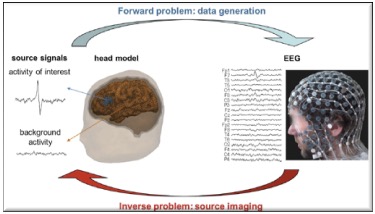The SISEA track (Signal Image SystEms Automatic control) of the EEA (Electronic electrical Energy Automatic control) Master 2 programme of the University of Rennes 1
Purpose of the SISEA track.
This training aims at providing the students with the necessary competences to become creative specialists in one of the following areas, which correspond to three different options of the SISEA track:
Signal and image processing

Embedded systems

Automatic control
Example of project.
ElectroEncephaloGraphy (EEG) is a non-invasive technique that records brain activity with a high temporal resolution using an array of sensors, which are placed on the scalp. The measurements contain valuable information about the electromagnetic brain sources that are at the origin of the observed cerebral activity. This information is crucial for the diagnosis and management of some diseases or for the understanding of the brain functions in neuroscience research. In this project, we focus on the application of EEG in the context of epilepsy. More particularly, we are concerned with the localization of the epileptic regions, which are involved in epileptic activity between seizures. The precise delineation of these areas is essential for the evaluation of patients with drug-resistant partial epilepsy for whom a surgical intervention can be considered to remove the epileptogenic brain regions that are responsible for the occurrence of seizures. The objective thus consists in identifying the positions (and spatial extents) of brain sources from the noisy mixture of signals which is recorded at the surface of the head by the EEG sensors. This is known as the inverse problem. Finding a solution to the inverse problem is still a challenging task. This is especially the case in the context of multiple sources with correlated time signals that can be involved in the propagation of epileptic phenomena. This problem is the key issue of this project and motivates the evaluation of algorithms based on sparsity in a transformed domain that are robust to source correlation.
How to start your application.
Application for the SISEA track of the EEA Master 2 programme is made online through our degree finder or by means of the "Etudes en France" platform. We also invite you to send an email to Laurent Albera.